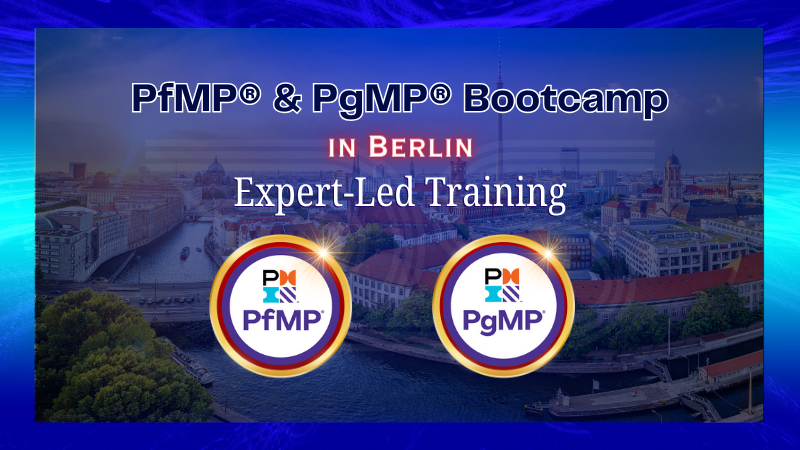
by Dharam CW2 | Mar 5, 2024 | Project-Program-Portfolio Management Knowledge
PgMP and PfMP Bootcamp | Berlin | Germany
Exciting update! I’ll be in Berlin this April 2024, leading specialized boot camps for PgMP and PfMP certifications. Join me for comprehensive training and guidance to excel in your certification journey. These boot camps are tailored to boost your Project, Program and Portfolio management skills. Use this opportunity to advance your career and embark on your path to success!
Here are the links for our upcoming sessions:
PgMP Berlin Bootcamp: April 07-09 – https://bit.ly/3upkUkf
PfMP Berlin Bootcamp: April 12-14 – https://bit.ly/3OrtQMS
Reach out to me for Exclusive Discounts ! ! !
🚀 Elevate Your Project Management Career:
– Register for my upcoming PgMP/PfMP Success Story Webinar: https://bit.ly/3ON2Ibl
– Book an obligation-free consultation session on Project management Career, training, and certifications: http://talktodharam.com
– Discover training offers and certification discounts: https://bit.ly/3jWVepD
– Stay updated with our Q&A series and certification success stories by subscribing to the vCare Project Management YouTube channel at https://bit.ly/2YF0wJl
– Follow my podcasts and interviews with Project Management Experts on YouTube at https://bit.ly/2NDY8wd
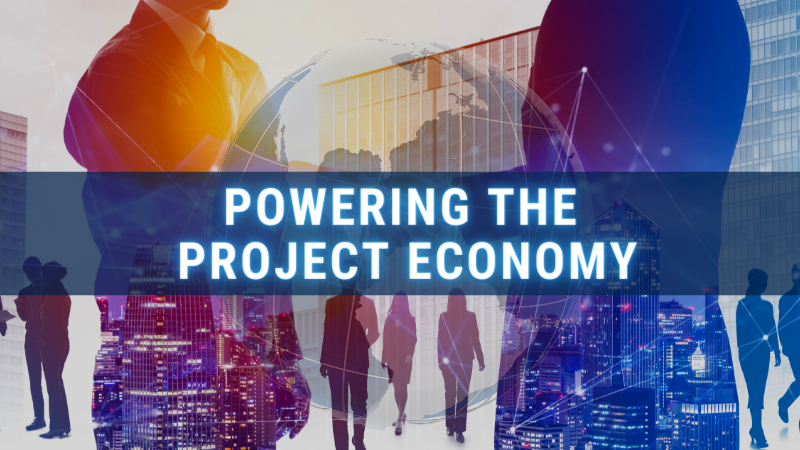
by DharamCW | May 20, 2022 | Project-Program-Portfolio Management Knowledge
Ideas into Reality
People have the skills to work on projects, but they need to be channelized across multiple projects. These skills are the ones that help in the success of the projects. In the end, the people’s skills and capabilities in the project serve to turn ideas into reality. That is when the project delivers value to its stakeholders. The people are the enablers for the growth and transformation of the projects. Ideas can be converted into reality by achieving the right mix of skills and capabilities in people.
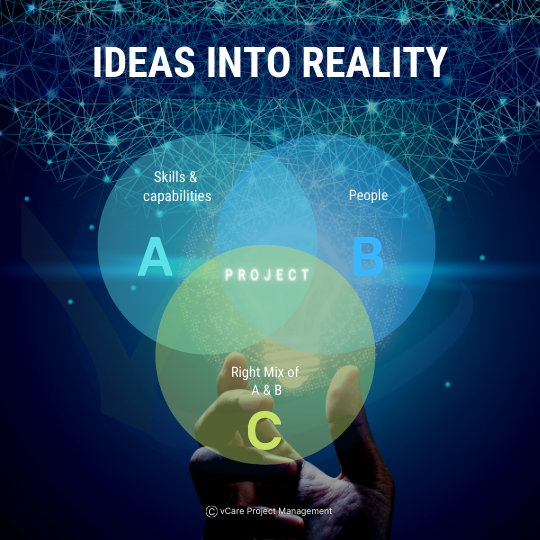
Ideas into Reality
The Project Economy at Work
The skills are utilized in project-based structures included in large organization’s portfolios and programs.
According to Professor and author Roger Martin, one of the world’s top-ranked management thinkers, this kind of approach is called “projectization,” where the everyday tasks become projects by themselves. Such trends are on the rise as “Gig Economy” is part of the project economy, which has been largely adopted by organizations like Ola, Uber, Airbnb, etc.,
People with varied skills, experience, and capabilities are brought onto one project to deliver value to the stakeholders. The resources are aligned at the portfolio level and mobilized to the projects on-demand based on priorities. Such an approach minimizes the cost of hiring, training, and retention. They all evolve into a high-performing workforce as they started merging into the socio-cultural aspects of the portfolio capabilities.

GIG ECONOMY
For example, companies like Zappos adopt a culture wherein the onboarded people or hired people are put onto their call centers to understand the various departments involved in the process and understand the pain they undergo. Post that, they will be able to get the context and core values of the organization, which were they can synchronize. It’s all about the task at hand than the title itself.
Vital skills in Project Economy
The Project Economy needs uniquely human skills such as leadership, creativity, and empathy.
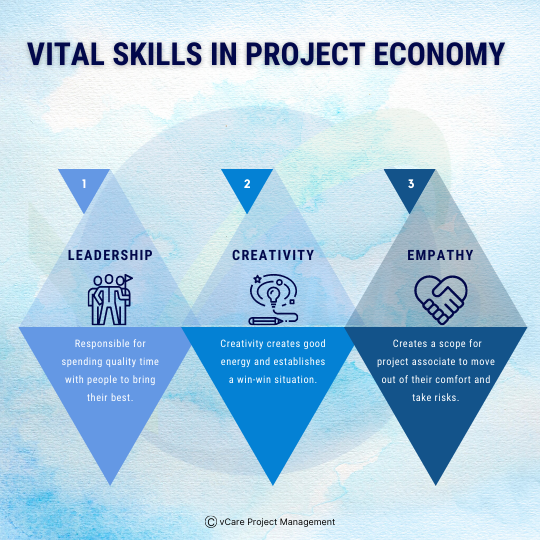
Vital skills in Project Economy
Leadership – Need to bring in the best of human potential. When the project economy is adopted, the people will move from role-based work to project-based work. As projects are going complex, a project manager is responsible for spending quality time with the people to bring their best.
Creativity – Creativity helps to find solutions to the problem in novel ways. Co-creation along with the stakeholders would minimize the postponement of decisions. It also extracts the thinking power of the participants creating new options. Creativity also creates good energy and establishes a win-win situation. Creativity can be fostered by providing an appropriate space to the team, decluttering the workplace, adopting a design thinking approach, etc… Foster an environment where creativity is recognized and rewarded
Empathy– When the project manager applies empathy, it creates scope for project associates to move out of their comfort zone and takes risks. It also brings on agility and helps reduces stress through minimized conflict. With empathy kindness and compassion becomes the natural ingredient promoting teamwork and leadership among individuals. Empathy can be exhibited by the project manager who is willing to be vulnerable and has the mindset to listen to all and exhibit leadership by walking the talk.
Project Economy Adoption
In the Middle East
There are many infrastructure projects already underway in the Middle East, such as Smart City, Higher Education, expansion of health care, etc… These projects bring changes to the digital infrastructure, transportation, and allied government service. Already in Dubai International Project Management Forum plays a vital role in megaprojects, including Construction of Digital Twin, Asset Project Management, BIM Implementation for Roads and Transportation Authority, Solar Park. All of these projects need people to execute. People are needed with the right skills to provide value to the stakeholders.
In the European Union
Case Study-1: Municipality located in Southern part of Sweden with more than 32000 inhabitants having organization size of 2400 full time and permanent employees have been organized as seven administrative departments. EU-funded projects were executed, and the projectification of departments, including public health, was achieved.
- The municipality has educated themselves and other organizations surrounding them, which helped effectively manage the EU funds and create competent project organization where employees make sense of their work.
- This move is transforming the civil servants, politicians to handle project activities affecting their organizing the style and overall impact on their performance routine.
- Implies changes where routines, or day-to-day activities, to an increasing extent are organized and understood, as if they were projects.
Case Study-2: Totally program worth 67.9 billion was allocated for the operational program through the EU. Territorial Self Government Units covering 57 offices were involved in a Survey related to identifying the benefits of Projectification
- Labor market institutions, up to 100% of offices declared that projects are never abandoned in the course of their lifetime
- In 96% of the projects, there was no change in the planned budget
- 89% of projects were completed according to the original schedule
- In 96% of the projects, there was no change in the planned budget
- Public organizations acting in this way make use of opportunities that arise in their environment, which proves their flexibility in adapting to changing conditions
- Changes in organizational structure are a temporary adaptation to the changes that have occurred in the external environment
Case Study-3: Automotive, Manufacturing, Engineering-Procurement-Construction (EPC), 2006 Football World Cup, Establishment of the Tsunami Early Warning System in South-East Asia.
- GPM study on projectification in Germany, almost 50% of working time in the manufacturing industry is spent on project work (GPM 2015)
- The project economy will generate 15% of value-added in Germany in 2020 (in 2007, it was 2%).
- The mean value shows that around 37% of all work processes in corporations are now organized in a project-oriented manner.
Summary:
As priorities change in these difficult times rapidly, project organizations need to embrace change. The Project Management office needs to build a team that commits to success. Project economy adoption is already a reality in various regions of the world. There are proven cases wherein successful projects are delivering values. Let’s focus on turning ideas into reality.
Feel free to check out my discussion on this topic with Dr. Reinhard Wagner in YouTube
You can subscribe and follow my podcasts and interviews with Project Management Experts on YouTube at https://bit.ly/2NDY8wd
You can subscribe to vCare Project Management YouTube Channel to catch future videos of our certification Q&A series and student success stories using the link https://bit.ly/2YF0wJl
For any questions related to Project Management career, training, and certifications, you can book an obligation free 15 minutes session with me by visiting talktodharam.com
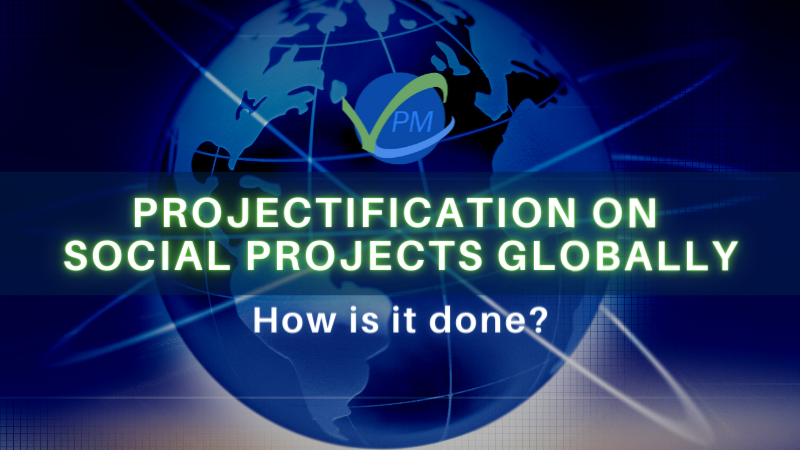
by DharamCW | Apr 26, 2022 | Project-Program-Portfolio Management Knowledge
- Implementing public policies through projects is driven through global organizations such as World Bank, UNICEF, UN, etc., encouraging projectification practices that drive down activities vertically deep down.
- Implementation and deployment of public policies are time-framed. Hence, they are projectified.
- Projectification is seen as a key strategic measure for getting things done concerning the EU.
- OpenPM² is a project management methodology designed by the European Commission for interoperability solutions for public administrations, businesses, and citizens.
- We introduce projects to the public sector managers’ toolkit in the smallest offices and teach how to build project portfolios in the largest public units.
- The Polish public sector used the external funds and started to fully “think project-wise.” Because projectification of activities was a “sine qua non” condition, none of the countries joining the EU structures can fully integrate with them if there are no competencies regarding project management.
- To receive and implement a project, people have to organize themselves into teams – so projects build micro-communities and unite people around a common goal, often involving stakeholders who have so far been excluded.
Models such as GPM3 can help manage the implementation and evaluation of projectification efforts and their maturity, as given in the figure below.

Governmental Project Management Maturity Model (GPM3®)
Governmental Project Management Maturity Model (GPM3®)
A maturity model is the sequence of groups (levels) of more efficient practices in any activity area. Our base area for defining maturity levels are Governmental Project Implementation and Governmental Project Management treated together as one system. The first source of our inspiration was Capability Maturity Model Integrated (CMMI ©) – probably the first widely recognized and probably best-known maturity model. The second source of inspiration was the Organizational Project Management Maturity Model (OPM3©) – a maturity model for the organizational level.
Initial Level
Some governments are (really!) not interested in managing their projects and investments. They think it is enough to allocate the budget and set the deadline for product delivery, and people will know how to do it. We say about such governments that they are at the lowest, Initial level of project management maturity.
Local Level
At some moment, people in individual governmental agencies and organizations, worried about continuous failures of their projects and inefficient work, learn that efficient and effective project management methods exist. After some time, they manage to convince their organization executives that it is worth implementing them throughout the organization. If project management methods are implemented only in some governmental organizations, we say that the given government has reached the Local level of project management maturity.
Governmental Level
After some time, the cabinet learns that a few of its projects (either internal or foreign governments) were implemented more efficiently than anywhere else. This awareness resulted in implementing project management methods, techniques, and processes to work in all government projects. This way, project management maturity in that state reaches the Governmental level.
Cooperating Level
But should the government only define the ways of project implementation and passively observe the results of these processes? It is better if the government is actively involved in implementing projects, like trying to solve problems faced by – usually complex and complicated – government projects. Then we say that governmental project management has reached the Cooperating level.
Optimizing Level
But this is not the end of the journey to the top of the ladder of maturity. Everything can always be done better (if there is such a need). The most advanced governments – such as the US Federal Government – command its ministries and agencies to improve project (and program) management processes constantly. Then we say that the given government has reached the Optimizing level of project management maturity. And this description of progressively achieved levels of project management maturity (which can be observed in some countries) is called the Government Project Management Maturity Model (GPM3®).

Think global, Act local
Think global Act local: Committed project management individuals are experts at acquiring funding and coordinating support for their solution. In terms of projectification, these characteristics of the project champion are skills that are disseminated and encouraged across local government organizations. These Project Managers need to have the skills to cut across culture, language and have the ability to influence the groups for projectification.
Involve in fieldwork to get closer
- Connect with the local people at the ground level and understand the ground situation better for such implementations.
- Observe in the meeting and participate in meetings based on the dynamics involved with civil servants in different departments.
- Be available at the field level to have empathy towards the problem in projectification.
The more you become closer to them, the better operational goodness.

Fieldwork
Projectifications impact on BaU (Business as Usual)
- Activities are organized and realized as projects.
- Projects are the new form of work and mechanism for change.
- Enforcing the way of projectification through regulations, framework, and practices
- Projects in the public sector impact governance and help adopt previous best practices.
- Helps to identify and pilot a new way of work
- Helps developing new strategies and shaping the future for the society through innovation and joint learning, and
- In some cases, organizations might use projects for dealing with controversial issues that the permanent organization does not want to deal with.
Conclusion
In the global setting, Projectifications provide organizations with the ability to link multiple business partners and respond quickly to market demand and supplier needs while remaining flexible enough to anticipate and respond to rapid shifts in consumer preferences. The positive impact has been proven, so countries and its government need to enable the Civil Servants to become better project management and program management professionals for seamless projectification. This move would lead to a better economy, GDP and generate an extraordinary value stream across the government services.
Feel free to check out my discussion on this topic with Dr. Reinhard Wagner in YouTube
You can subscribe and follow my podcasts and interviews with Project Management Experts on YouTube at https://bit.ly/2NDY8wd
You can subscribe to vCare Project Management YouTube Channel to catch future videos of our certification Q&A series and student success stories using the link https://bit.ly/2YF0wJl
For any questions related to Project Management career, training, and certifications, you can book an obligation free 15 minutes session with me by visiting talktodharam.com
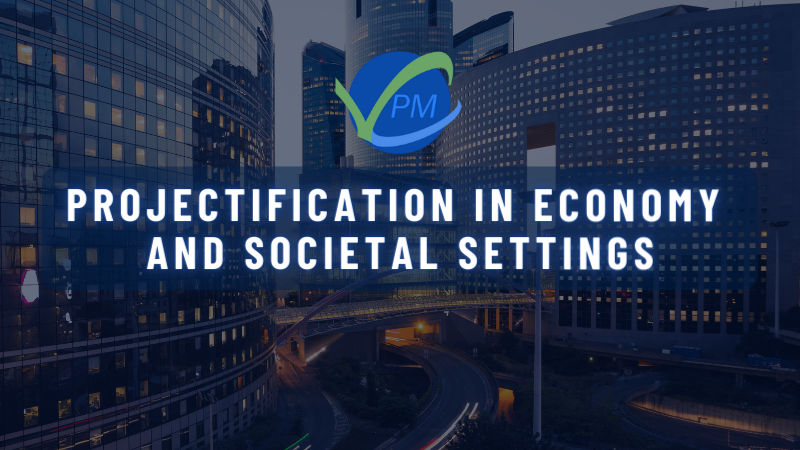
by DharamCW | Mar 29, 2022 | Project-Program-Portfolio Management Knowledge
In the public sector, as Mats Fred (2018, p. 189) indicates:
Projectification as proliferation emphasizes the increasing use and diffusion of projects and project ideas. Projectification as transformation and adaptation highlights the transformation of “permanent” ordinary organizational activities to temporary projects and processes of adaptation in the surrounding organizations and structures. Projectification as an organizational capacity building in which the project logic is spread and diffused in local government organizations, not primarily through specific projects, but through practices encouraging the project logic and reinforcing local government’s organizational project capacity.
The term “Project” itself would be considered as a temporary endeavor. Projectification involves the cultural and discursive societal processes whereby projects and project-like circumstances are institutionalized in individual lives, organizing all sorts of work and society. They are to be planned, controlled, managed with dedication and commitment. In a societal setting, it calls for flexible action and task-focused social relations.
Understanding the Societal Setting

Understanding the Societal Setting
When the boundaries of the project go beyond the organization, societal settings come into place. Societal settings focus on developing and providing solutions together. When the projects are managed and executed at the societal level, it becomes a more collaborative effort. This kind of environment calls for global communication, collective intelligence, identifying skills across the board to leverage. Project execution should focus on accomplishing the tasks by adopting agile principles with empowering the team. The focus should be working through the community via effective networking.
Factors that could affect projectification in societal impact
There could be an influence at a Project Level, Political, Bureaucratic and Market Level. To a varying degree, local government involved in the societal settings would have specific practices that correspond to a political, bureaucratic, and market context. In terms of projectification, there could be complementary or contradictory aspects in nature that need to be managed well. Projectification translation could be done based out on specific settings and practices.
The societal context would have to manage multiple institutions yet need to bring them with a common goal and vision despite indifferences. This aspect needs to be dealt with using Decoupling, Compromising, and Combining depending on the situation and environment. These practices will de-escalate tensions in arriving at a consensus on the focus area or goals.
The project budget needs to be derived from the policies wherein the costs are derived from the social investment funds. This action would mean cutting across the government and local bodies in the region. Sometimes these funds are advocated by World Bank, EU, IMF, etc… Using such funds would also call for strong coordination among the various stakeholders across different processes and procedures. Managing such funds could be tiresome and painful.
Be in the realm of the project in the implementation context. It would look like a smooth sail as initiation would be easy on the ground implementation could be a posing challenge. Focus on the welfare benefits, lower costs for the larger group during the implementation. Understand the potential areas of resistance early in the project upon the various factors including economic, environmental, etc.,
Projectification involves managing an organization to manage two types of complexity involving task complexity and Social complexity. Task complexity refers to the density of the units, causal links, and consequences within a temporal and spatial frame. Social complexity describes the number of members communicating and working with each other and the differentiation of their tasks. In contrast, cultural complexity encompasses the number of different historical experiences and sense-making processes confronting each other in a project.

Factors that could affect projectification in societal impact
The three projectification studies in Germany, Norway, and Iceland show that project work contributes to one-third of the national gross domestic product. Although differences exist among the countries regarding size and industry structure, the degree of projectification of advanced economies seems to converge on around one-third of all economic activities. The exact results showed that the share of project work in Germany was 34,7% in 2013, and 32,6% in Norway, and 27,7% in Iceland in 2014 (Schoper et al., 2018).
The projectification in the public or governance societal segment was more towards improving, modernizing the managerial approach towards the commoner or public. The projects were part of the public sector in the infrastructure area, such as Road Construction, Dam Construction, construction, and larger institutions, and their Projectifications are not sudden. Based on one of the research study by Schuster in 2015, he identified three key factors which seem to provide public/civil service organizations to adopt projectification. They are:
- Quick Mobilization
- Strategic approach towards managing the change
- Accountability and Transparency to stakeholders
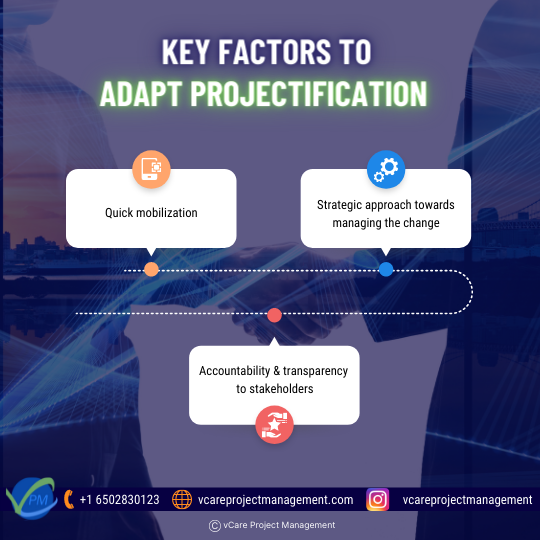
Key factors to adopt projectification
It is also to be realized that the ongoing social and economic change and the increase in public sector stakeholder’s innovation and entrepreneurship are most needed in this sector. Projectification helps to meet the void, which can help implement public policies, thus enabling changes in resolving social problems. Even though the benefits exist on projectification, it is not implemented due to the factors such as – Excess bureaucracy, Causes lack of trust, lack of persistence, etc.,
Conclusion
Projectification provides benefits to the people involved to know how to lead a team, influence people, and negotiate or resolve conflict. It would be a combination of more organizing activities to the organizations and transforming ordinary activities into projects. And increasingly, everybody needs to feel comfortable working in a digital environment.
Feel free to check out my discussion on this topic with Reinhard Wagner in YouTube
You can subscribe and follow my podcasts and interviews with Project Management Experts on YouTube at https://bit.ly/2NDY8wd
You can subscribe to vCare Project Management YouTube Channel to catch future videos of our certification Q&A series and student success stories using the link https://bit.ly/2YF0wJl
For any questions related to Project Management career, training, and certifications, you can book an obligation free 15 minutes session with me by visiting talktodharam.com

by DharamCW | Dec 21, 2021 | Project-Program-Portfolio Management Knowledge
Project economy is all about people having the skills and capabilities which enable organizations to turn ideas into reality. The key is these projects should deliver financial and societal value through value streams incrementally delivered through projects. The following are the key six factors identified by PMI that influence the projectification in the project economy.
Climate Change
Buildings are being modified, new products are being introduced, new policies and regulations are being applied. Climate factors are one of the biggest factors influencing global projects. Climate central report found that about 300 million people in coastal Asia would be at risk because of rising sea levels by 2050. Apart from this, people worldwide are fighting to manage droughts, flash floods, volcanic eruptions, and raging wildfires. Climatic changes are a global threat, and many young minds are asking for actions from global leaders. This kind of awareness and activism increases action at the ground level, and project leaders are responsible for those actions inducing change.
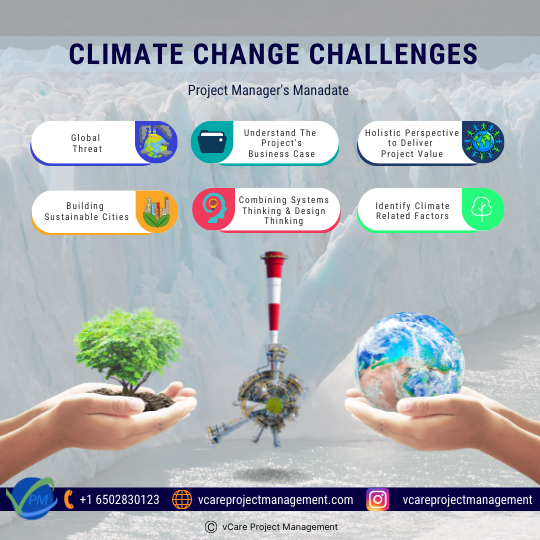
Climate Change Challenges
Infrastructure projects like building sustainable cities can increase green space, manage water risk, etc… These projects directly or indirectly contribute to overall sustainability as well. These complex problems are issues that require a combination of systems and design thinking. The project managers need to respond based on a big picture perspective to manage a complex environment. Nowadays, companies need to have projects on climate projection and sustainability front as a matter of compliance and corporate social responsibility.
The project manager needs to practice agile as these projects change quickly along with technology that changes rapidly. Climate change-related factors influence every sector/industry. The project manager’s mandate is to understand the project’s business case and identify the climate-related factors to deliver project value. Projects, programs, and portfolios have to be aligned to understand this and act with a more creative, front-end-oriented approach for tomorrow’s challenge. Therefore, the role of project managers and program managers is going to impact the future generation.
Artificial Intelligence (AI)
Artificial Intelligence adoption has just begun. The responsibility of appropriate implementation lies with project leaders mitigating societal-related risks, including ethical issues. As healthcare, consulting, and manufacturing industries have started adopting, uncertainty looms at a large adoption and transition. However, tools like RPA and AI have already started contributing to the automation of business processes at large, replacing humans doing monotonous jobs.

Impact of Artificial Intelligence on Project Management
In the recent IPMA and PwC report in October 2020, AI is considered a tool, and it’s more adopted for automation to augmentation and beyond changing the future. According to this report, 56% of the organization already has digital transformation projects, including AI adoption. However, it also highlights that 77% of the project managers don’t have experience in using AI technologies in Project management, indicating that the adoption is still in its early stages. Artificial Intelligence will change project management in Integration, Documentation, Reporting, Forecasting, Budgeting, Resource Allocation, and Predictive analytics.
AI systems can help connect different Enterprise applications, including HR, Task Management Tools, repositories, etc. It can help set intelligent reminders to mitigate risks. AI tools can help in drafting documentation and can help get the data from other systems. AI can also help to organize the documentation for quick recovery through recommendation engines. Task report completion, the status of the work, and milestone tracking can be managed effectively by AI-based reporting. Adopting AI tools can help anticipate the problems early through prognosis with the help of specific indicators.
AI tools can help the project manager by helping with insightful information by analysis of Big Data or real-time stream of data. Decision-making aided by AI can be very useful for the project manager to take decisions or actions in the behavioral areas of people management, including Influence, Negotiation, Motivation, etc… Human touch is a factor that cannot be avoided, and AI can never replace it, yet it can aid. AI adoption in project management can significantly help project managers in Productivity, Decision, and Performance.
Adopting Chatbots can help provide the project’s status, follow-up reports, providing templates, project plan, and status can help human resources work on something much more productive. This initiative will enable project professionals to think more strategically and prepare well-defined, high-level plans. Analysis of the project with the help of statistical or AI models would identify and quantify the risks. This aspect would also help in what-if analysis and validate the certain hypothesis to justify the stakeholders involved. It’s expected the current adoption of AI among project professionals will move from 27% to 35% in the next three years. So, this calls for the project management professionals to invest their time in people skills which will never go away yet understanding the AI paradigm.
Globalization
The business, which is growing at a global scale in terms of people, trade of goods and service, information exchange, has taken an economic toll and countries started showing protectionist measures regarding trade policies, immigration, and work policies. Globalization will impact the future global trade, and countries will focus on inclusive growth to fuel the economy from within. Example(s): BREXIT, US-China Trade issues.
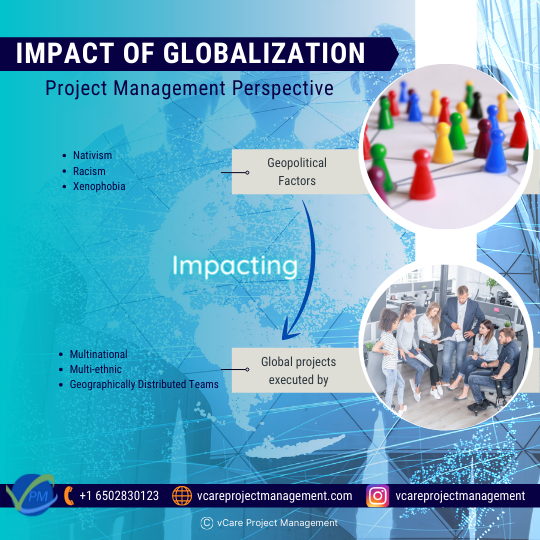
Impact of Globalization | Project Management Perspective
The COVID-19 situation has also added to the existing woes and has impacted global travel and trade. Apart from this, geopolitical factors, including nativism, racism, xenophobia, are impacting global projects executed by multinational, multi-ethnic, and geographically distributed teams. All these challenges are to be managed by the project managers. In addition, the increased volatility of the situation reflecting the business landscape and job market has to be managed by the project managers.
Project managers need to effectively remote work amidst geopolitical situations by collaborating, managing time zones and cultural aspects. Project leaders have to become Virtual Leaders managing lack of commitment, distractions, poor communication, low motivation, etc. This kind of change can be well managed by effective portfolio management driven at the organization level to minimize adverse impact.
Infrastructure Gap
For any investment that is capital intensive, there is a need to understand the data for decision-making. For example, the G20 global infrastructure outlook estimates that US$94 trillion is required by 2040 across 56 countries and seven sectors, but the budget falls short by US$15 trillion. The gaps exist depending on the investment required in this area concerning the current trends, which vary in different demographics.
The project managers and program managers are expected to be smart and agile for cutting costs and helping to expedite the operations faster. The infrastructure investment has been increasing for 3D Printing, Artificial Intelligence, Modularization, Robotics, IoT with Digital Twins for transformation. Singapore is currently working on a project to create a digital twin of the entire city-state.
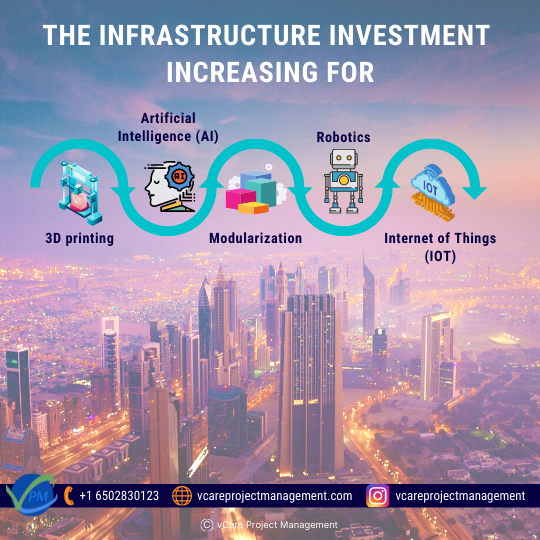
The Infrastructure Investment
The adoption of IoT infrastructure to collect more data is getting more attention. In addition, the advent of technology communication infrastructures such as 4G and 5G has increased cloud data streaming capabilities. As a result, operational efficiency, including an increase in productivity and extending of asset life, could be done only with the help of data and analytics.
Large megaprojects on infrastructure areas such as Dubai Solar Park and the Bridge linking Hong Kong to Macau and Zhuhai have large complexities and challenges posing more risks. It is also about augmenting the capacity required to get on with such mega projects. These projects also need to manage or defend political and financial pressures (Example: Halted 13$ billion airport projects in Mexico) through creative means to meet societal needs. Project managers need to address fiscal prudence and transparency.
Project and program offices also need to attain the balance on leveraging local and global suppliers on Megaprojects. Portfolio managers are finding difficulty in people who have experience managing projects of massive size and complexity. The infrastructure Gap to manage these gaps must be well understood by the project professionals, who must wisely adopt the necessary tools required for these endeavors.
Cybersecurity
According to the PMI signpost 2020 report, US$3.92 million is the average cost of data breaches globally in 2019. As we grow more digital, a push is happening in business, governments, and non-profit on how they operate as they are interdependent. Organizations are managing cybercrime, information warfare, and various threats at all different new levels.

Impact of Cybersecurity on Project Management
Project leaders need to work with cybersecurity teams as the projects are progressing to manage cybersecurity requirements while building solutions. It is essential to understand that classification of information and its sensitivity to manage the threats faced. Non-IT sectors need to gain more awareness in the cybersecurity areas, and it needs to be implemented as an integral part of the organization.
Project managers of the future need to consider the value of data regardless of their domain. They need to understand the importance of understanding data ownership and the potential impact of data loss or breach. Understanding the cost impact of protecting the data assets also has to be counted in the projectification process. Risk management must encompass Cybersecurity as part of it as well.
Shifting Demographics
Key changes are happening in the areas of overall population demographics. The youth population is on the rise, and project managers need to align their leadership styles to suit the target audience more. In addition, the urban landscape is changing globally, and villages are becoming more urbanized with the young population who may lack the necessary experience with the new world. It is also difficult to navigate the projects with them. Also, we need to manage and make the best use of the job market with many young minds available.
Underdeveloped countries are moving across. For example, many projects are going on in African countries building infrastructure for their growth. This expansion would build the future for the people, and these countries willing to participate in the projects for creating a better world would require more understanding at a strategic level.
Feel free to check out my discussion on this topic with Reinhard Wagner in YouTube
You can subscribe and follow my podcasts and interviews with Project Management Experts on YouTube at https://bit.ly/2NDY8wd
You can subscribe to vCare Project Management YouTube Channel to catch future videos of our certification Q&A series and student success stories using the link https://bit.ly/2YF0wJl
For any questions related to Project Management career, training, and certifications, you can book an obligation free 15 minutes session with me by visiting http://talktodharam.com/

by DharamCW | Nov 9, 2021 | Project-Program-Portfolio Management Knowledge
What is a Project?
PMI defines endeavour as “a temporary endeavor undertaken to create a unique product, service or result”. Projects give an organisation focus to excel. “Project” is a huge, broad word that has such rich possibilities in terms of helping define how people do what they do and how organisations achieve their goals, create change, and deliver value. We shouldn’t think of projects by their features or attributes but on what needs to be done and figure out the best way to do it. It is expected that by 2027, employers will need approximately 87.7 million individuals working in project management-oriented roles.
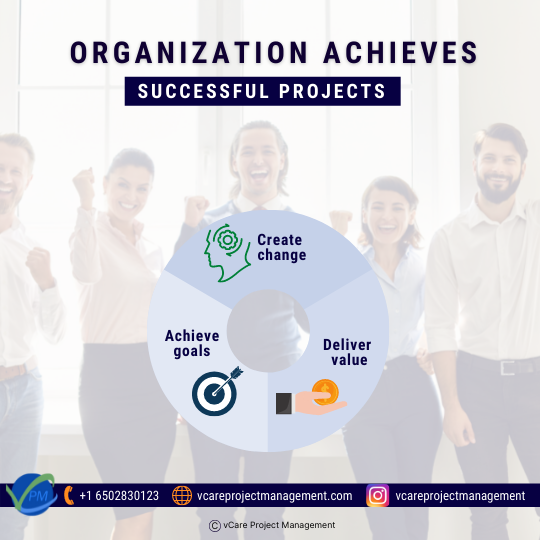
Successful projects
Everyone has a project. People have projects on behalf of themselves and on behalf of others; they have their projects, and they have collective projects. We do projects at school, and we carry out projects at work. Add to that all our spare time projects, and how it is sometimes hard to tell work projects from spare time projects. Projects cut across. (Jensen, 2012)
What is project economy?
PMI defines project economy as a Paradigm shift in the business world toward using projects to handle work and solve problems. It emphasises that organisation in general needs project leaders who can help to manage real-world challenges. The Pulse of the Profession report well backs this aspect.
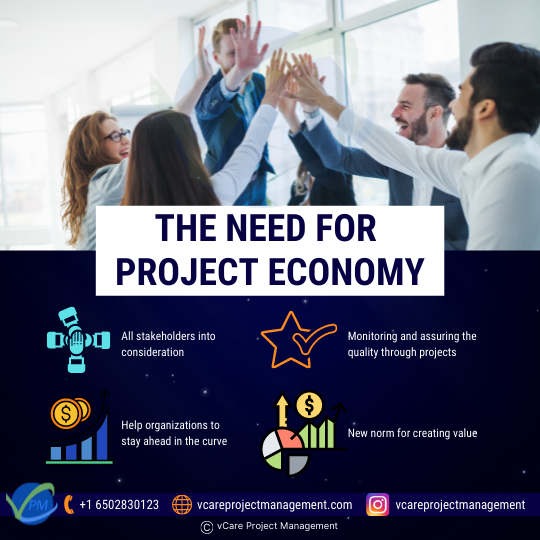
The Need for Project Economy
The Need for Project Economy: Changing Scenario
Projects with unique objective induce a change in the organisation and society at large. The project approach takes all the stakeholders in the process of obtaining the project objective. Project managers are required to be inclusive, and they cannot take a parallel approach. The project economy drives this change.
Though the management thinkers like Frederick Taylor, Henry Ford, Dr William Edwards Deming recommended continuous improvement of the business’s operations, these improvements were considered projects and executed as projects. Advancements in computing and technology have driven operational excellence at the core. Yet, disruptive technologies and the speed of technology growth drive differently, and it calls for many projects. Projects are seen as a new norm for creating value and help organisations to stay ahead in the curve.
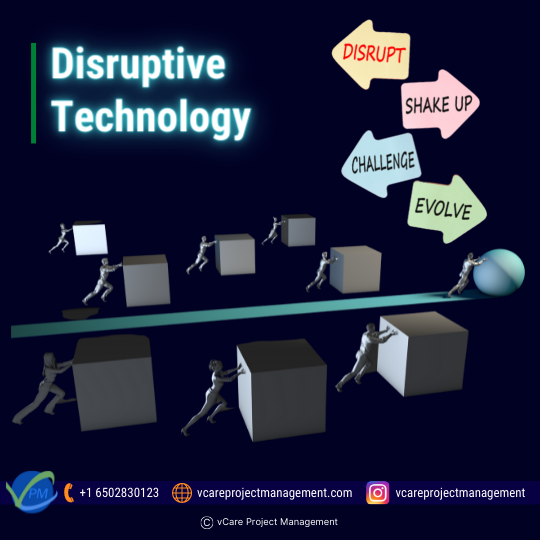
Disruptive Technology
Project work has been seen as more administrative and seen as a low value from the frontline of the management due to extensive documentation and paperwork. Rationale, business Case and benefits were not given sufficient importance in project management methodologies. As the technology and tools for collaboration are fast-changing, agile triggers, project aspects like “Working software over documentation”, “individual interactions over process and tools”, etc., are largely adopted. Technology and engineering help bespoke run the project, making the project managers at the centre of the process. With automation taking over, projects are becoming a critical part of the organisation. Now everything around the people lives are becoming projects, and this fact can be emphasised with every professional’s career as a good example.
People keep track of changes from previous jobs, recording and sharing their learnings. They move from one job to another compared to previous situations where people stuck to one job for a longer tenure. As they move to different companies, the learning is multi-fold and its applied cutting across domains enriching experience.
As organisations are growing more in complex and chaotic environments, “Project Oriented Methodology” helps define action and helps manage change appropriately with a specific set of goals. Project management methods help to improve the performance of individuals and teams.
Monitoring and assuring the quality through projects help us assess its value and deliver it. Project management strategies help to keep costs on budget and reduce the risk of budget overrun. Learning lessons from failure and being agile helps to adapt. Project professionals play a pivotal role in managing the projects and contribute with the right blend of technical and people capabilities. Hence projectification would be the future order, reiterating the fact, where it is expected that employers will need around 87.7 million project management professionals by 2027.

Project Management-Oriented Roles

Country-wise Project Managers Jobs Projection
What is Projectification?
Projectification, the term was introduced by Christophe Midler in 1995 in his research paper “Projectification of the Firm: the Renault Case”. In this, he analysed the relationship between project management and organisation, with a case study of “Renault” on “Projectificiation”, an organisation undergoing a four-phased transition from the 1960s. This study is believed to be a construct of project orientation taken from the novel management approach “Management by Projects” by Gareis in 1989.
“The Project Revolution- How to succeed in a project Driven World”
In the book “The Project Revolution- How to succeed in a project Driven World”, Antonio Nie recommends a Project canvas composed of 14 dimensions that are capable of influence and determine project success across four domains:
- Why?
- Why is this project taken up?
- What is the purpose and passion behind the rationale?
- Why successful implementation important?
- Who?
- Who is accountable?
- Governance of resources and delivery
- What, How and When?
- Details of Definition, Design, Plans, Milestones, Cost, Risk, etc.,
- Power Skills: Empathy, Motivation, Change management, Communication.
- Where?
- Culture
- Prioritisation
- Organisation context
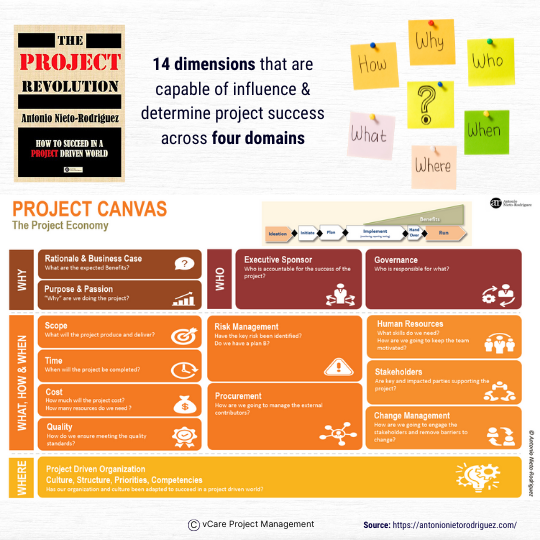
The Project Revolution
Check out my discussion on this topic with Reinhard Wagner in YouTube
You can subscribe and follow my podcasts and interviews with Project Management Experts on YouTube at https://bit.ly/2NDY8wd
You can subscribe to vCare Project Management YouTube Channel to catch future videos of our Q&A series and certification success stories using the link https://bit.ly/2YF0wJl
For any questions related to Project Management career, training, and certifications, you can book an obligation free 15 minutes session with me by visiting talktodharam.com
Conclusion
Projectification is becoming the order of the day, and it’s going on increasing trends. As a project manager or project professional, it’s important to understand how organisations, government and stakeholders are evolving. The disruptive changes happening in technology and rapid growth is influencing many facets of project management. As project professional, as we start manoeuvring them, we can create value for others and us for a better world.


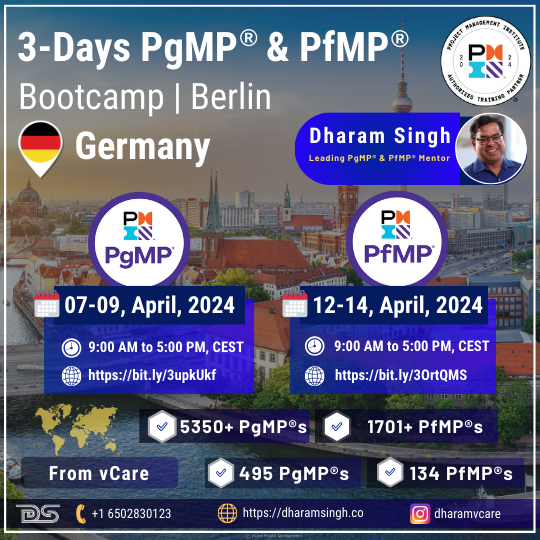






























Recent Comments